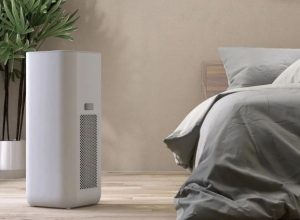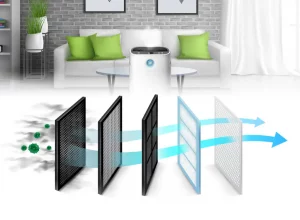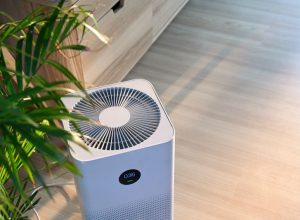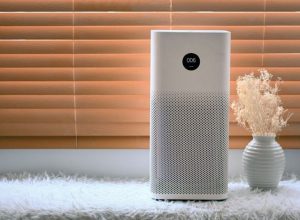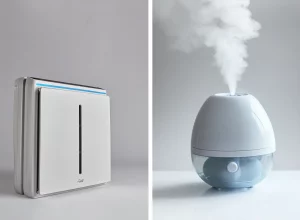Contents
Understanding Air Purifier Size
Choosing the right size air purifier is essential for ensuring optimal air quality in any room. The efficiency of an air purifier is largely determined by its ability to clean the air volume of the space it occupies. In order to select the appropriate air purifier size, it is crucial to consider several factors beyond just the dimensions of the room.
Key specifications, such as the Clean Air Delivery Rate (CADR), play a vital role in understanding the effectiveness of a unit. CADR measures the volume of filtered air produced by an air purifier and is typically indicated in cubic feet per minute (CFM). A higher CADR value means that the air purifier can filter air more quickly and efficiently.
To determine the right size air purifier for a specific room, calculate the square footage by multiplying the length by the width of the room. However, it’s not only the area that matters; the height of the room is also important, as it affects the total volume of air that needs to be purified. For instance, an 8-foot ceiling in a 10 by 12-foot room means the total volume is 960 cubic feet. In general, a unit should have a CADR that is at least one-third of the room’s total volume to ensure proper air circulation and purification.
Besides room volume, various factors such as occupancy, usage of the space, and local air quality can influence the choice of an air purifier. High occupancy levels, for instance, generate more pollutants, thereby necessitating a more powerful unit. Additionally, if the room is used for specific activities leading to increased levels of allergens—such as cooking in a kitchen or having pets in a living room—an air purifier with specialized filters and a higher CADR can be more suitable.
Some manufacturers provide air purifier sizing calculators on their websites. These tools allow consumers to input their room dimensions, specific needs, and local air quality conditions to recommend the most effective unit. It is also critical to position the air purifier correctly within a room. Ideally, it should be placed at least a few feet away from walls and furniture to allow for proper air intake and circulation.
In summary, selecting an air purifier is a process that requires taking a comprehensive look at both quantitative measurements and qualitative aspects of your environment. By understanding the specifics of your space and the performance capabilities of potential units, you can effectively improve indoor air quality while ensuring that the air purifier operates at peak efficiency.
Key Terminology
Before diving into the selection process, it’s crucial to understand a few key terms associated with air purifiers:
- CADR (Clean Air Delivery Rate): This metric measures the volume of filtered air delivered by the air purifier. It is expressed in cubic feet per minute (CFM).
- Room Size: This refers to the area in square feet of the room where the air purifier will be used.
- ACH (Air Changes per Hour): This indicates how many times the air purifier can filter the room’s air in one hour.
Calculating the Right Size Air Purifier
The first step in choosing the right size air purifier involves measuring your room dimensions. Follow these steps:
- Measure the length and width of the room to calculate the total area in square feet (sq ft).
- Use the following formula for area calculation: Area = Length x Width.
- For rooms with different length and width, simply apply the formula to both dimensions.
Determining CADR Requirements
Once the area is calculated, you can determine the required CADR for effective air purification. A general rule of thumb is to aim for a CADR rating that is at least two-thirds of the room size in square feet. For example, for a 150 sq ft room, the minimum CADR should be approximately 100 CFM.
Table: Recommended CADR Values Based on Room Size
| Room Size (sq ft) | Recommended CADR (CFM) |
|---|---|
| 100 | 67 |
| 200 | 133 |
| 300 | 200 |
| 400 | 267 |
| 500 | 333 |
Considering Air Changes per Hour (ACH)
The ACH indicates how often you want the air in the room to be filtered in one hour. For general air quality and allergen removal, aim for an ACH of 4 to 5. This means your air purifier will clean the air within the room four to five times each hour.
To calculate the required CADR based on ACH, use the formula: CADR = (Room Size in sq ft x ACH)/60.
Additional Considerations
Beyond the size of the room and the CADR, consider the following factors:
- Air Purifier Type: Different types of air purifiers (HEPA, activated carbon, UV, etc.) have varying efficiencies. Select one that fits your specific air quality needs.
- Noise Level: Larger units often produce more noise. If sound is a concern, factor this into your decision.
- Filter Replacement Costs: Account for ongoing maintenance costs associated with changing filters to maintain performance.
- Room Layout: Consider airflow patterns in the room. Avoid placing the purifier in corners or obstructed areas.
Conclusion
Choosing the right size air purifier involves measuring your room, understanding CADR and ACH, and considering additional factors. By following these guidelines, you can ensure that your air purifier operates efficiently, providing clean and healthy air in your living space. Whether it’s for a small bedroom or a larger living area, the correct sizing will enhance the effectiveness of your air purification efforts.

